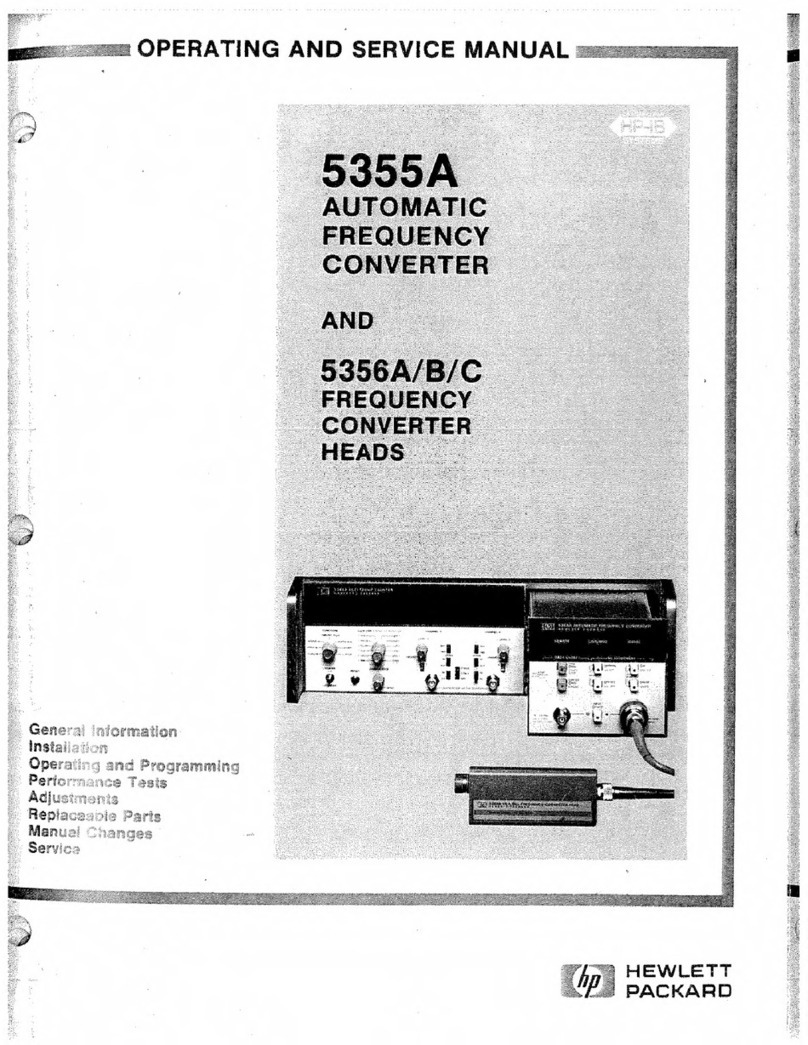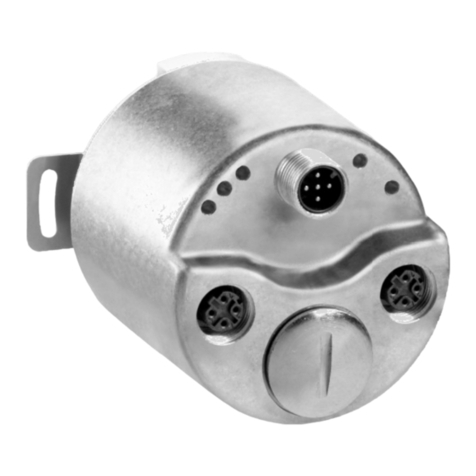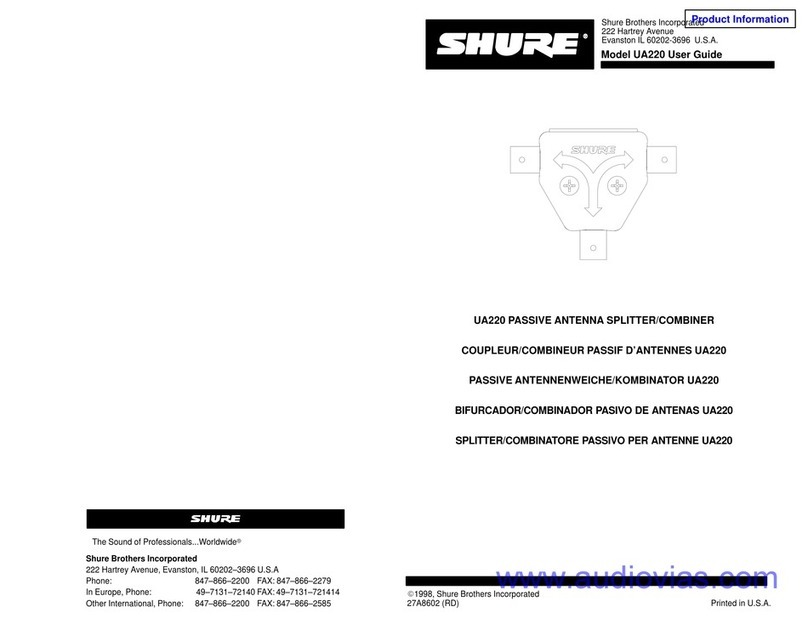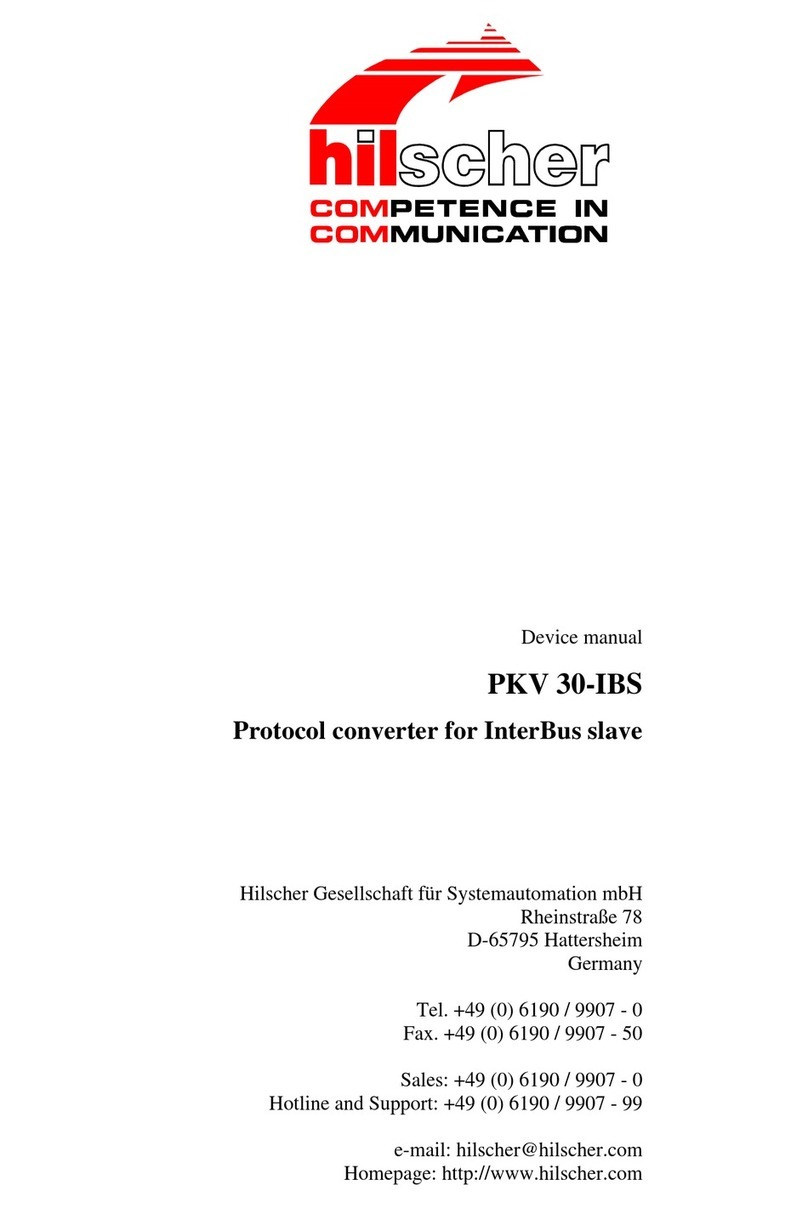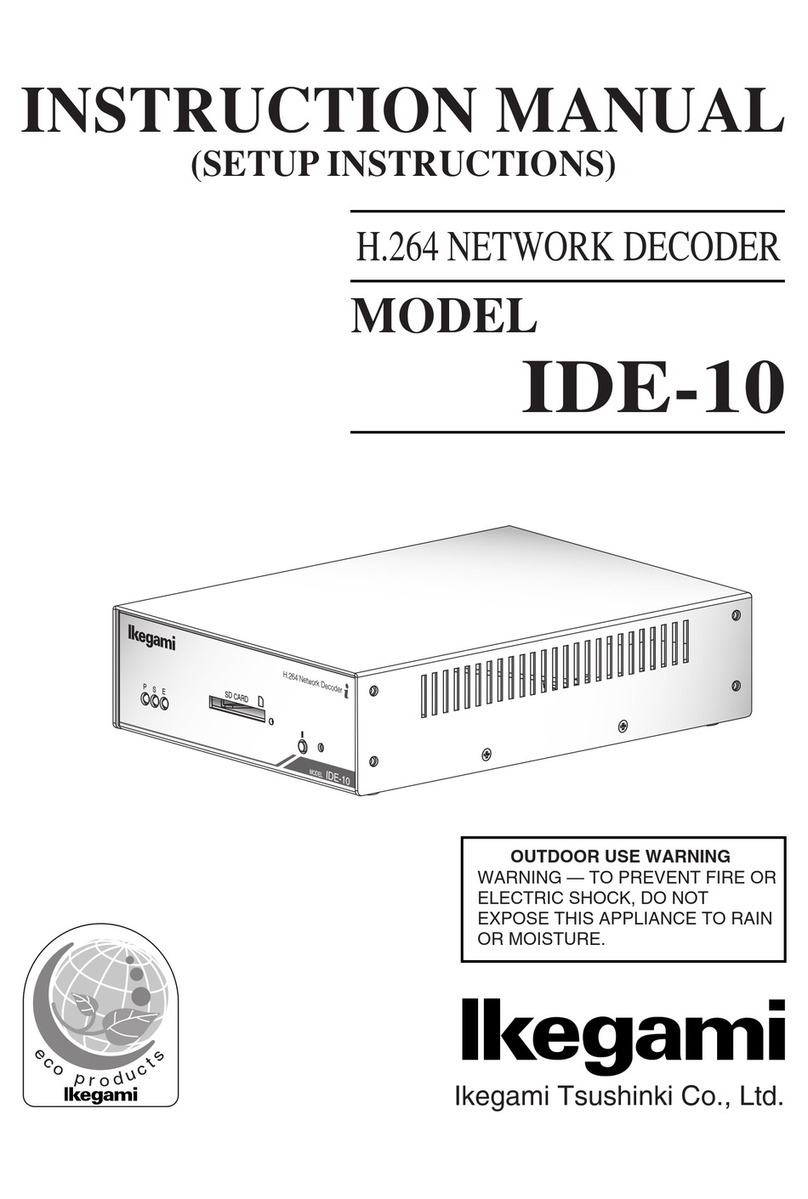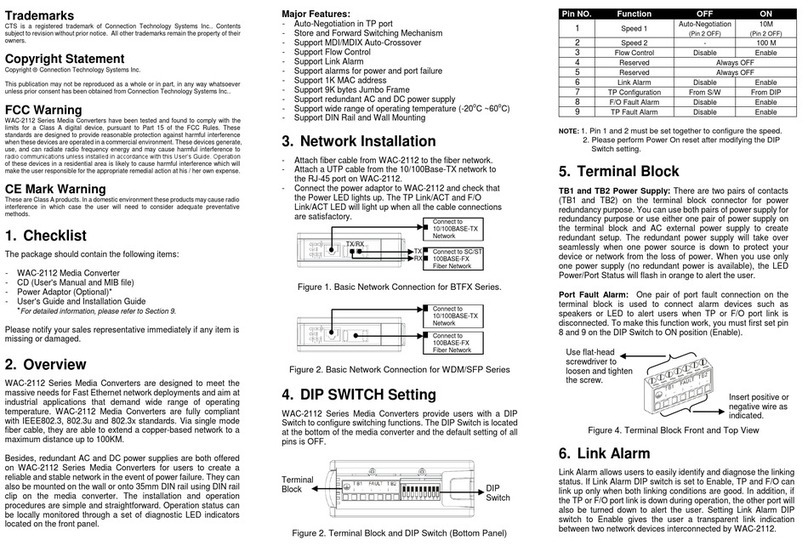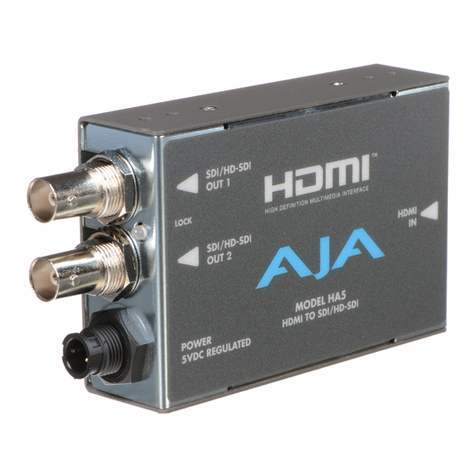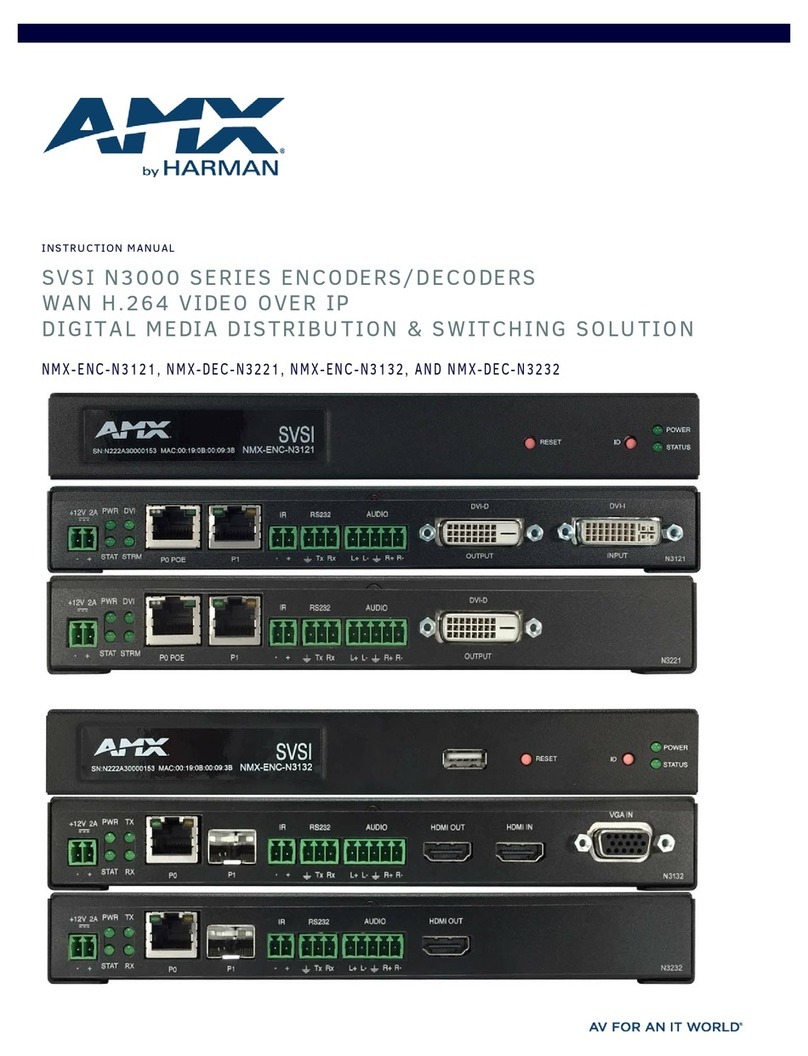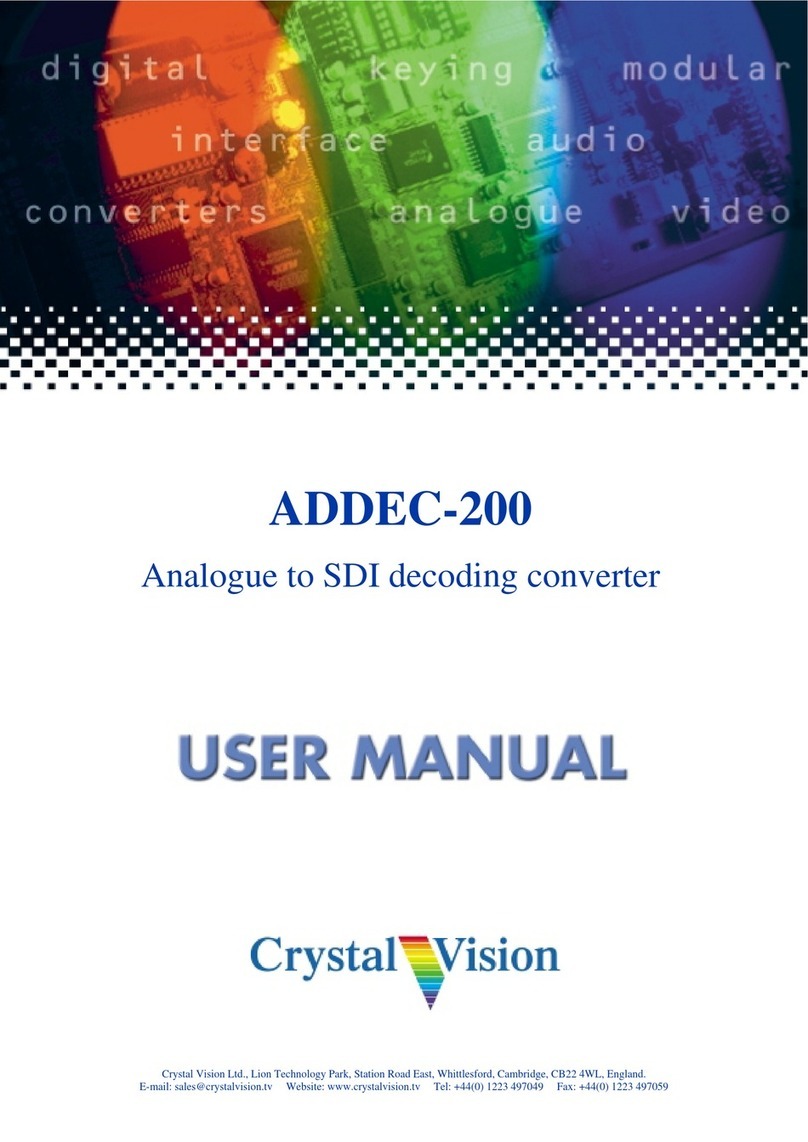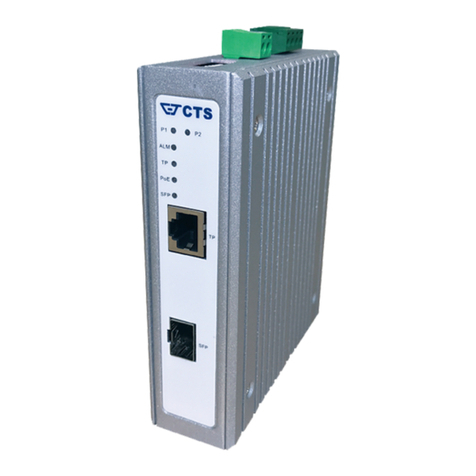Simex SPT-86L User manual

Assisting the automation
industry since 1986
User manual
for RTD,TC,mV/ -20mA converter
module
SPT-86L
•Firmware: v.1.00 or higher
Read the user's manual carefully
before starting to use the unit or software.
Producer reserves the right to implement changes without prior notice.
31.05. 011 SPT-86L_INSSXEN_v.1.00.000

User manual for RTD,TC,mV/4-20mA converter module SPT-8 L
CONTENTS
1. BASIC REQUIREMENTS AND USER SAFETY........................................................................................2
2. GENERAL CHARACTERISTICS................................................................................................................3
3. TECHNICAL DATA......................................................................................................................................3
4. DEVICE INSTALLATION............................................................................................................................5
4.1. UNPACKING.......................................................................................................................................5
4.2. ASSEMBLY........................................................................................................................................5
4.3. CONNECTION METHOD...................................................................................................................6
4.4. MAINTENANCE..................................................................................................................................7
5. PRINCIPLE OF OPERATION.....................................................................................................................8
5.1. VOLTAGE MEASUREMENT.............................................................................................................8
5.2. CURRENT OUTPUT CONTROL........................................................................................................9
5.3. ORCING O ADDRESS H........................................................................................................10
5.4. DETECTION O THE PEAK VALUES............................................................................................11
6. MEASURED VALUES CALCULATION....................................................................................................11
6.1. ADDITIONAL CALCULATIONS (USED CONVERSION CHARACTERISTIC)...............................12
6.1.1. Linear characteristic................................................................................................................12
6.1.2. Square characteristic..............................................................................................................12
6.1.3. Square root characteristic.......................................................................................................13
6.1.4. User defined characteristic.....................................................................................................13
6.2. EXAMPLES O CALCULATIONS...................................................................................................14
7. CURRENT OUTPUT VALUE CALCULATION.........................................................................................17
8. THE MODBUS PROTOCOL HANDLING.................................................................................................18
8.1. LIST O REGISTERS......................................................................................................................18
8.2. TRANSMISSION ERRORS DESCRIPTION....................................................................................20
8.3. EXAMPLES O QUERY/ANSWER RAMES.................................................................................21
. DEFAULT AND USER'S SETTINGS LIST...............................................................................................23
Explanation of symbols used in the manual:
- This symbol denotes especially important guidelines concerning the installation and
operation of the device. Not complying with the guidelines denoted by this symbol
may cause an accident, damage or equipment destruction.
IF THE DEVICE IS NOT USED ACCORDING TO THE MANUAL THE USER IS
RESPONSIBLE FOR POSSIBLE DAMAGES.
- This symbol denotes especially important characteristics of the unit.
Read any information regarding this symbol carefully
1. BASIC REQUIREMENTS AND USER SAFETY
- The manufacturer is not responsible for any damages caused by
inappropriate installation, not maintaining the proper technical condition
and using the unit against its destination.
- Installation should be conducted by qualified personnel . During installation all
available safety requirements should be considered. The fitter is responsible for
executing the installation according to this manual, local safety and EMC
regulations.
2
i
!
!

User manual for RTD,TC,mV/4-20mA converter module SPT-8 L
- The unit must be properly set-up, according to the application. Incorrect
configuration can cause defective operation, which can lead to unit damage or
an accident.
- If in the case of a defect of unit operation there is a risk of a serious threat
to the safety of people or property additional, independent systems and
solutions to prevent such a threat must be used.
- Neighbouring and mating equipment must meet the requirements of appropriate
standards and regulations concerning safety and be equipped with adequate
anti-overvoltage and anti-interference filters.
- Do not attempt to disassemble, repair or modify the unit yourself. The unit
has no user serviceable parts. Units, in which a defect was stated must be
disconnected and submitted for repairs at an authorized service centre.
The unit is designed for operation in an industrial environment and must
not be used in a household environment or similar.
2. GENERAL CHARACTERISTICS
The S T-86L module is an isolated temperature and voltage to current (in 4- 0 mA
standard) converter. The device is equipped with one voltage input (0-150 mV), one RTD input
(Pt 100/500/1000) and one TC (thermocouple) input (K, S, J, T, N, R, B, E). The device
automatically compensates the cold junction temperature. Both RTD and TC inputs have full
linearisation of characteristics. Only one type of input can be used at a time. Ranges of
individual inputs are given in the next chapter. The module is able to detect a break of any of
the measurement wire. The measurement after being processed according to the scale given
by the user is used to drive the passive current output.
The configuration of the device can be done on request or by the user. The
communication with the device is through RS-485 interface with Modbus RTU protocol.
The supply input together with RS-485 interface, measurement input and current output
are all galvanically isolated from each other.
3. TECHNICAL DATA
Power supply voltage 16...24...36V DC (separated)
External fuse (required) T - type, max. 1 A
Current consumption typically 0.65 W
Voltage input (150mV range) 0÷60 mV, 0÷75 mV, 0÷100 mV, 0÷150 mV
Voltage measurement accuracy ± 0.1% @ 5°C; ± one digit (for 0÷150 mV range)
Voltage input resistance > 1,5 MΩ
Accepted prolonged input overload + 0%
3
!
!

User manual for RTD,TC,mV/4-20mA converter module SPT-8 L
RTD input (resistive) Pt 100, Pt 500,Pt 1000
Measurement range -100°C ÷ +600°C
Measurement accuracy ± 0.1% @ 5°C; ± one digit
Measurement wires resistance max. 0 Ω (every wire)
Thermocouple input K, S, J, T, N, R, B, E
Thermocouple input range K: - 00˚C ÷ +1370˚C
S: -50˚C ÷ +1768˚C
J: - 10˚C ÷ +1 00˚C
T: - 00˚C ÷ + 400˚C
N: - 00˚C ÷ +1300˚C
R: -50˚C ÷ +1768˚C
B: + 50˚C ÷ +18 0˚C
E: - 00˚C ÷ +1000˚C
Measurement accuracy K, J, E: ± 0.1% @ 5°C; ± one digit
N: ± 0. % @ 5°C; ± one digit
S, T, R, B: ± 0.5% @ 5°C; ± one digit
Accuracy of cold ends temperature
compensation
± 1˚C
Temperature stability 50 ppm / °C
Galvanic isolation Supply input together with RS-485 interface,
measurement input and current output are all
galvanically isolated from each other
Passive current output range max. .8 ÷ 4 mA,
supply voltage: Us = 9.5 ÷ 36 V
load resistance 0...(Us - 9.5V) / 4mA [kΩ]
resolution: 1 bits
Communication interface RS-485, 8N1 and 8N , Modbus RTU, not separated
from power supply circuit
Baud rate 1 00 bit/s ÷ 115 00 bit/s
Number of modules in 1 network maximum 1 8
Data memory non-volatile memory, EEPROM type
Protection level IP 0
Housing type
Housing dimensions (L x W x D)
DIN rail mounted (35 mm rail)
101 x .5 x 80 mm
4

User manual for RTD,TC,mV/4-20mA converter module SPT-8 L
Operating temperature
Storage temperature
Humidity
Altitude
0°C to +50°C
-10°C to +70°C
5 to 90% no condensation
up to 000 meters above sea level
Screws tightening max. torque 0.5 Nm
Max. connection leads diameter .5 mm
EMC according to: PN-EN 613 6-1
This is a class A unit. In housing or a similar area it can cause radio
frequency interference. In such cases the user can be requested to use
appropriate preventive measures.
4. DEVICE INSTALLATION
The unit has been designed and manufactured in a way assuring a high level of user
safety and resistance to interference occurring in a typical industrial environment. In order to
take full advantage of these characteristics installation of the unit must be conducted correctly
and according to the local regulations.
- Read the basic safety requirements on page prior to starting the installation.
- Ensure that the power supply network voltage corresponds to the nominal
voltage stated on the unit’s identification label.
- The load must correspond to the requirements listed in the technical data.
- All installation works must be conducted with a disconnected power supply.
4.1. UNPACKING
After removing the unit from the protective packaging, check for transportation damage. Any
transportation damage must be immediately reported to the carrier. Also, write down the unit
serial number on the housing and report the damage to the manufacturer.
Attached with the unit please find:
- user’s manual,
- warranty,
4.2. ASSEMBLY
- Disconnect the power supply prior to starting assembly.
- Check the correctness of the performed connections prior to switching the unit on.
5
!
!
!

User manual for RTD,TC,mV/4-20mA converter module SPT-8 L
4.3. CONNECTION METHOD
Caution
- Installation should be conducted by qualified personnel . During installation all
available safety requirements should be considered. The fitter is responsible for
executing the installation according to this manual, local safety and EMC
regulations.
- Wiring must meet appropriate standards and local regulations and laws.
- In order to secure against accidental short circuit the connection cables must be
terminated with appropriate insulated cable tips.
- Tighten the clamping screws. The recommended tightening torque is 0.5 Nm.
Loose screws can cause fire or defective operation. Over tightening can lead to
damaging the connections inside the units and breaking the thread.
- In the case of the unit being fitted with separable clamps they should be inserted
into appropriate connectors in the unit, even if they are not used for any
connections.
- Unused clamps (marked as n.c.) must not be used for connecting any
connecting cables (e.g. as bridges), because this can cause damage to the
equipment or electric shock.
Due to possible significant interference in industrial installations appropriate measures
assuring correct operation of the unit must be applied. To avoid the unit of improper
indications keep recommendations listed below.
–Avoid common (parallel) leading of signal cables and transmission cables together with
power supply cables and cables controlling induction loads (e.g. contactors). Such cables
should cross at a right angle.
–Contactor coils and induction loads should be equipped with anti-interference protection
systems, e.g. RC-type.
–Use of screened signal cables is recommended. Signal cable screens should be
connected to the earthing only at one of the ends of the screened cable.
–In the case of magnetically induced interference the use of twisted couples of signal
cables (so-called ”spirals”) is recommended. The spiral (best if shielded) must be used
with RS-485 serial transmission connections.
–In the case of interference from the power supply side the use of appropriate anti-
interference filters is recommended. Bear in mind that the connection between the filter
and the unit should be as short as possible and the metal housing of the filter must be
connected to the earthing with largest possible surface. The cables connected to the filter
output must not run in parallel with cables with interference (e.g. circuits controlling relays
or contactors).
Connections of power supply voltage and measurement signals are executed using the
screw connections on the front and bottom of the unit’s housing.
!

User manual for RTD,TC,mV/4-20mA converter module SPT-8 L
ig. 4.1. Method of cable insulation replacing and cable terminals
• When use of SM S it is strongly recommended to connect E wire.
• All connections must be made while power supply is disconnected !
ig. 4.2. Terminals description
4.4. MAINTENANCE
The unit does not have any internal replaceable or adjustable components available to
the user. Pay attention to the ambient temperature in the room where the unit is operating.
Excessively high temperatures cause faster ageing of the internal components and shorten the
fault-free time of unit operation.
In cases where the unit gets dirty do not clean with solvents. For cleaning use warm water with
small amount of detergent or in the case of more significant contamination ethyl or isopropyl
alcohol.
Using any other agents can cause permanent damage to the housing.
Product marked with this symbol should not be placed in municipal waste. Please
check local regulations for disposal and electronic products.
7
!
!
6-7 mm
max. mm
9
10
PASSIVE current
output 4 ÷ 20mA
(polarization doe n't
matter)
bottom view
RS-485
SLAVE
RUN
ERROR
5 6 7 8
+Us A+ B- -Us
power upply
ground
power upply
+24V DC
front view
force addre 0xFF wich
i available through thi hole
3 2 1
RS-485 3 2 1
TC
4 3
-+
RTD RTD
4 1
mV
+

User manual for RTD,TC,mV/4-20mA converter module SPT-8 L
5. PRINCIPLE OF OPERATION
S T-86L module allows the conversion of temperature and voltage on current in 4- 0 mA
standard. Present value of temperature or voltage is available as measurement register of
device (reg. addr. 01h). If input signal exceeds the permissible range, shortcut or break of
measurement circuit occur, appropriate error code will be set in status register (register 0 h).
Measurement input's parameters are located in the group of registers ”Input” (see LIST
OF REGISTERS on page 18) and allow:
• input type selection (parameter ”InputType”)
• connection type selection (parameter ”InputConn”, applies only to RTD measurement),
• change of the filtration degree of the values in measurement register (parameter
”InputFilter”),
• shift of the measurement scale (parameter ”InputOffset”, applies only to temperature
measurement),
• processing characteristic setup (applies only to voltage measurement).
The proper operation of the module is signalized by flashing green LED diode placed on
the front panel and labelled RUN. The yellow LED diode (labelled RS-485), by fast flashes,
signalizes data transmission via serial interface. The red LED diode (labelled ERROR), if lit,
signalizes measurement error. It may mean that measured signal exceeded the permissible
range, the sensor was damaged or wires' short circuit or break occurred.
Parameters are kept in non-volatile EEPROM memory. All parameters can be set via
serial interface (see LIST OF REGISTERS on page 18).
5.1. VOLTAGE MEASUREMENT
Measurement results can be internally recalculated due to one of available
characteristics: linear, square, square root or user definable multipoint (max. 0 points length).
The expansion of nominal range is defined by ”InputHiRange” parameter (see figure below).
ig. 5.1 Example of definition of permissible range of input signal - ”InputHiRange”
parameter (0-100 mV mode)
8
”InputHiRange” = 5,0 % (5 mV)
105
permissible measurement range
nominal measurement range (0-100 mV)
[mV]
100 1 00
Umax
range exceeded range exceeded

User manual for RTD,TC,mV/4-20mA converter module SPT-8 L
If input signal exceeds the permissible range, appropriate code in status register (register
0 h) will be set.
Parameter ”InputHiRange” determines the upper border of the permissible range
accordingly to the expression (for all voltage modes). For example, if input is set to 0-100 mV
mode, then the upper border is calculated due to expression:
Umax = 100 mV + 100 mV × ”InputHiRange” %.
Value of ”InputHiRange” can be set from 0 to 19.9% (the procedure of calculating the input
voltage range is presented in the example no 1 on the page 14).
When linear, square or square root characteristic is chosen then the value returned to the
measurement register (register 01h) is defined by ”InputLow” and ”InputHigh” parameters.
These parameters describe the values returned for minimum and maximum input value. For
example, if input type is set to 0-100 mV, ”InputLow” parameter defines the returned value
when input voltage equals 0 mV, and ”InputHigh” parameter defines the returned value for
100 mV. Available range for these parameters: -999 ÷ 9999.
When user defined multipoint characteristic is chosen then the value returned in
measurement register (register 01h) is calculated according to coordinates defined by user (X,
Y points, maximally 0 points). Coordinate ”X” defines the percentage ratio of input value to
selected measurement range. The „X” range: -99,9 ÷ 199,9. Coordinate ”Y” defines the value
(returned in measurement register) for particular ”X” coordinate. The ”Y” value can be changed
in range: -999 ÷ 9999.
5.2. CURRENT OUTPUT CONTROL
Way of processing the measurement to the current value is determined by the
parameters contained in the "Output" group of parameters (see LIST OF REGISTERS on
page 18).
The current output can be controlled on the basis of the measurement result or on the
basis of the value written to the register 05h via the serial interface (remote control mode via
RS-485).
In control mode using the measurement result parameter ”OutLow” defines the
measurement value for which current equal 4 mA will be generated, while the parameter
”OutHigh” defines the measurement value for which current equal 0 mA will be generated.
Output current for any result can be calculated from the formula:
Iout=W−"OutLow"
"OutHigh"−"OutLow" ×16 mA4mA
where ”W” is a measurement value in the register (01h or 06h - depending on the parameter
”HoldOut”).
•In control mode based on the measurement result the current output can be
controlled by the present value (register 01h) or by the stored peak value
(register 06h, in the case of using the peak detection function - see parameter
”HoldOut”).
• Value of parameter ”OutLow” can be greater than the value of parameter
”OutHigh”. In this case, the characteristic of the current output is reversed (ie,
9
i

User manual for RTD,TC,mV/4-20mA converter module SPT-8 L
when the measured value is increasing the output current is decreasing).
Parameters ”OutLoRange” and ”OutHiRange” define the permissible output current
range beyond the nominal range 4- 0 mA. If the calculated current Iout would exceed the
permissible range, the output would generate current equal to the upper or lower border of the
range. Parameter ”OutLoRange” defines the lower border of the range due to formula:
Imin = 4 mA - 4 mA × ”OutLoRange” %
Parameter ”OutLoRagne” can be set from 0 to 9.9%. Parameter ”OutHiRange” defines the
lower border of the range due to formula:
Imax = 0 mA + 0 mA × ”OutHiRange” %
Parameter ”OutHiRange” can be set from 0 to 19.9%.
The minimum current which can flow in the current output's circuit is about .5 mA. It
occurs when the current output is disabled (parameter ”OutMode”). This is the current
needed to power the current output circuit.
Parameter ”OutAlarm” defines how the current output reacts in the critical situation
(exceeding the permissible range, shorting or opening measuring inputs). In such a situation
the output current will be unchanged or will be set to the desired value (depending on the
parameter ”OutAlarm”).
•Critical situation is signalized by the red LED (labeled ERROR).
• After resolution of the critical situation output current returns to the value
determined on the basis of the measurement result.
• Before turning off the device it is recommended to first disable the current output's
power supply, and then the device itself. If the current output is supplied while the
device itself is turned off, the output current will be about 7.5 mA.
5.3. FORCING OF ADDRESS FFH
New devices has set to Modbus addresses FEh. To enhance system installation process
special operation mode has been developed. It allows to force address FFh in single module
using internal momentary switch mounted on module mainboard (fig. 4.1). Switch is accessible
through a small hole in .the front panel.
To change address of the device to FFh, wait for a moment after power up until green
LED (RUN) starts flashes. Next press and hold push-button about 4 seconds until green LED
will lights permanently, then release push-button.
The device changes its MODBUS address to FFh and waits for a new address
(readdressing). Green LED (RUN) stay permanently on until readdressing via RS-485, or
power off. While module is in this state it is possible to control its inputs, and communication is
possible using temporal address FFh.
At this moment MASTER controller should find new device and readdress it (to address
other than FFh and FEh). After remote readdressing green LED indicator starts to flashes
again.
Simultaneously with change of device address, its baud rate is changed to
9600 bit / s. Required transmission speed (1 00 bit/s. to 115 00 bit/s.) can be set by write to
register h. After change of transmission speed the device sends the answer with new baud
10
i
i

User manual for RTD,TC,mV/4-20mA converter module SPT-8 L
rate. While installation of the new network it is recommended to readdress all devices using
baud rate 9600 bit/s, and next change speed of all devices simultaneously, using
BROADCAST query (with address 00h).
5.4. DETECTION OF THE PEAK VALUES
The S T-86L module is equipped with peaks detection function. It can detect peaks of
the input signal and hold their values. Presets connected with this function are placed in group
of registers named ”Hold” (see LIST OF REGISTERS). The detection of the peak can be done
if the measured signal raises and drops of value at least equal to parameter ”Hold eak”.
Detected peaks are hold during the time defined by parameter ”HoldTime”. If a new peak will
be detected while one is hold, this new peak will be held and value holding time counter will
restarted (fig. 5. ). If no peaks are detected while time ”HoldTime” elapses, device returns the
current value of input signal in the peak value register (06h register).
The current output can be controlled depending on the current value of input signal (01h
register) or the peak value (06h register, see LIST OF REGISTERS).
ig. 5.2. Process of peaks detection
6. MEASURED VALUES CALCULATION
All calculations in the following examples are made for the input in 0-100 mV mode.
For temperature inputs (TC and RTD) only linear characteristic is available.
The first step to compute the result of measure is the calculation of the normalized result
(it means result of 0-1 range). To do it, the begin of the input range (0 mV for 0-100 mV range)
must be subtracted from measured value. Next, received result must be divided by the width of
the input range (it means 100 mV for 0-100 mV range). So normalized result can be expressed
by expressions:
Un=Uinp.
100 for range 0÷100 mV
11
”HoldTime”
measure
time
”HoldTime”
”Hold eak”
”Hold eak”
real measurement result
value in register 06h
i

User manual for RTD,TC,mV/4-20mA converter module SPT-8 L
where Uinp. means input voltage (in mV), and Un - normalized result.
If measured value exceeds the nominal input range (0-100 mV), and do not exceed
the permissible input range, then received normalized Un result will exceed 0-1
range, e.g. input range 0-100 mA and input voltage = -10 mV the normalized result
is equal -0.1, and for input voltage = 110 mV, the normalized result is equal 1.1. In
such cases presented expressions are still correct.
6.1. ADDITIONAL CALCULATIONS (USED CONVERSION CHARACTERISTIC)
The manner of the additional computation of the returned result depends on selected
conversion characteristic. All presented charts are connected with the input range 0-100 mV.
6.1.1. Linear characteristic
The normalized result is converted by fixed coefficients determined by ”InputLow” and
”InputHigh” parameters (when the normalized results is equal 0, then value ”InputHigh” is
returned, and when the normalized results is equal 1, then value ”InputHigh” is returned).
Expression presented below shows the manner of result calculation:
W=Un× "InputHigh" −"InputLow" "InputLow" ,
where W means the value returned in measurement register.
The value of the ”InputLow” parameter can be higher than the value of ”InputHigh”
parameter. In such a case, for an increasing value of input voltage the returned
value decreases.
ig. 6.1 Normal (”InputLow” < ”InputHigh”) and inverted (”InputLow” > ”InputHigh”)
characteristic.
6.1.2. Square characteristic
The normalized result is squared and further conversion is done as for linear characteristic.
Conversion is made accordingly with the expression:
W=Un
2× "InputHigh" −"InputLow" "InputLow" ,
12
Returned
value
Input voltate [mV]
-25 0 25 50 75 100
InputHigh
InputLow
Returned
value
Input voltage [mV]
-25 0 25 50 75 100
InputLow
InputHigh
i
i

User manual for RTD,TC,mV/4-20mA converter module SPT-8 L
where W means the value returned in measurement register.
ig. 6.2 Normal (”InputLow” < ”InputHigh”) and inverted (”InputLow” > ”InputHigh”)
characteristic.
6.1.3. Square root characteristic
The normalized result is rooted and further conversion is done as for linear characteristic.
Conversion is made accordingly with the expression:
W=
Un× "InputHigh" −"InputLow" "InputLow" ,
where W means the value returned in measurement register.
Showed above expression is not valid when normalized result is negative. In this
case (Un<0) the returned result is equal ”InputLow” (see graphs below).
ig. 6.3 Normal (”InputLow” < ”InputHigh”) and inverted (”InputLow” > ”InputHigh”)
characteristic.
6.1.4. User defined characteristic
User defined characteristic is defined as set of X-Y points. Number of the points is variable and
may be set from to 0 points which make linear segments (see figure below and ”UserChar”
group of registers). Due to the normalized result Un, the device computes specific segment,
e.g. for characteristic from figure below, and Un = 0,65 the segment between points X = ”50.0.”
and X = ”70.0.” will be chosen.
Let's mark those points as PL (point low) i PH (point high) - in this example PL= ”50.0.” and PH
= ”70.0.”, and the normalized result Un for the point PL as Up (in this example Up = Un(PL) =
13
Returned
value
Input voltage [mV]
-25 0 25 50 75 100
InputLow
InputHigh
Returned
value
Input voltage [mV]
-25 0 25 50 75 100
InputHigh
inputLow
i
Returned
value
Input voltage [mV]
-25 0 25 50 75 100
InputLow
InputHigh
Returned
value
Input voltage [mV]
-
25
025 50 75 100
InputHigh
InputLow

User manual for RTD,TC,mV/4-20mA converter module SPT-8 L
0.5). The returned result is calculated accordingly to the expression:
W=Un−Up × [YPH −YPL]
[XPH −XPL] ×100 YPL
where Y(PH), X(PH), Y(PL), X(PL) mean values of X and Y coordinates of PH i PL points.
If the normalized result exceeds the user defined characteristic values, then specific
utmost segment, defined by two next points, is used for calculations. If characteristic
from figure below is used, and if Un>1 then segment defined by points X(PL) =
”90.0.”, X(PH) = ”100.0.” will be used.
ig. 6.4 Example of user defined characteristic
6.2. EXAMPLES OF CALCULATIONS
Example 1: Selection of the permissible input range (”0-100” mode)
If in ”0-100” mode the user sets ”InputHiRange” = 10.0%, then permissible input voltage
range will be equal: 0÷110 mV. Upper border of the range is the result of calculations: 100 mV
+ 100 mV × 10%.
Example 2: The normalized Un result calculation
Let assume the input mode ”0-100” is chosen. The normalized Un result is calculated
accordingly to the expression on page 11. Assume that Uinp. = 37.5 mV, this value should be
divided by the width of input range (100 mV). Finally the normalized result: Un = 37.5/100 =
0.375.
In case when input voltage exceeds nominal measurement range, calculations are similar. For
14
Returned value
Prąd wejściowy [mA]
020 40 60 80 100
Y ( H)
0 0,2 0,35 0,5 0,7 1
0,9
Y ( L)
X = „20.0.”
X = „35.0.”
X ( L) = „50.0.”
X ( H) = „70.0.”
X = „90.0.”
X = „100.0.”
Input voltage [mV]
Normalized measurement Un (for 0-100 mVrange)
5-segment characteristic
i

User manual for RTD,TC,mV/4-20mA converter module SPT-8 L
example if input voltage is equal -9.38 mV then Un = -9.38/100 = -0.0938, and if input voltage is
equal 103.13 mV then Un = 103.13/100 = 1.0313.
Example 3: The linear characteristic
Let assume the input mode ”0-100” is chosen. Parameter ”InputLow” and ”InputHigh” equal
to -300 and 1 00 respectively. The calculations will be done for three different input voltages
from example .
a) Uinp. = 37.5 mV and Un = 0.375
Accordingly to expression on page 1 for linear characteristic:
0.375 × [1 00 -(- 300)] ≅ 56 and next, the ”InputLow” value is added to the result, so
the returned value equals:
W ≅ 56 + (-300) = 6
b) Uinp. = -9.38 mV and Un = -0.0938.
W ≅ -441.
c) Uinp. = 103.13 mV and Un = 1.0313.
W ≅ 1 47.
Example 4: The square characteristic
Let assume the input mode ”0-100” is chosen. Parameter ”InputLow” and ”InputHigh” equal
to -300 and 1 00 respectively. The calculations will be done for three different input voltages
from example .
a) Uinp. = 37.5 mV and Un = 0.375
Accordingly to expression on page 1 for square characteristic:
(0.375) × [1 00 -(- 300)] ≅ 11 and next, the ”InputLow” value is added to the result, so
the returned value equals:
W ≅ 11 + (-300) = -89.
b) Uinp. = -9.38 mV and Un = -0.0938.
W ≅ - 87.
c) Uinp. = 103.13 mV and Un = 1.0313.
W ≅ 1 95.
Example 5: The square root characteristic
Let assume the input mode ”0-100” is chosen. Parameter ”InputLow” and ”InputHigh” equal
to -300 and 1 00 respectively. The calculations will be done for three different input voltages
from example .
a) Uinp. = 37.5 mV and Un = 0.375
Accordingly to expression on page 1 for square root characteristic:
0,375
× [1 00 -(- 300)] ≅ 919 and next, the ”InputLow” value is added to the result,
so the returned value equals:
W ≅ 919 + (-300) = -619.
15

User manual for RTD,TC,mV/4-20mA converter module SPT-8 L
b) Uinp. = -9.38 mV and Un = -0.0938.
Normalized result is negative, so the returned value is equal to ”InputLow” parameter:
W = -300.
c) Uinp. = 103.13 mV and Un = 1.0313.
W ≅ 1 3.
Example 6: The user defined characteristic
Let assume the input mode ”0-100” is chosen, and the user selected the 10 segment
characteristic. To do this, it is necessary to enter X and Y coordinates of 11 points (see
registers 70h÷97h).
The calculations will be done for three different input voltages from example , so in
calculations some of the segments will be used only.
Let the following points will be given:
X1 = ”00.0.”, Y1 = ”-50.0”,
X = ”10.0.”, Y = ”-30.0”,
....
X6 = ”30.0.”, Y6 = ”30.0”,
X7 = ”40.0.”, Y7 = ”80.0”,
....
X10 = ”90.0.”, Y10 = ”900.0”,
X11 = ”100.0.”, Y11 = ”820.0”,
Additionally all other points must to be defined and stored in the device memory.
a) Uinp. = 37.5 mV and Un = 0.375
The segment defined by X6 = ”30.0.” and X7 = ”40.0.” for this Un will be selected. Accordingly
to expressions given for user defined characteristic (see page 14) X6(PL) = 30, Y6(PL) = 30,
X7(PH) = 40, Y7(PH) = 80 and Up = 0,3 , the returned value:
W=Un−Up × [YPH −YPL ]
[XPH − XPL] ×100 YPL=
=0.375−0.3 × [80−30]
[40−30]×100 30 ≃67
b) Uinp. = -9.38 mV and Un = -0.0938.
Because of the normalized Un value is lower than 0, the segment defined by X1 and X will be
selected. X1(PL) = 0, Y1(PL) = -50, X (PH) = 10,
Y (PH) = -30 and Up = 0. For these values the returned value W ≅ -69.
c) Uinp. = 103.13 mV and Un = 1.0313.
Because of the normalized Un value is higher than 1, the segment defined by X10 and X11 will
be selected, and X10(PL) = 90, Y10(PL) = 900,
X11(PH) = 100, Y11(PH) = 8 0 and Up = 0.9 for these values the returned value W ≅ 795.
1

User manual for RTD,TC,mV/4-20mA converter module SPT-8 L
7. CURRENT OUTPUT VALUE CALCULATION
Output current value may be calculated by the equation (described on page 9):
Iout=W−"OutLow"
"OutHigh"−"OutLow" ×16 mA4mA
where W means the measurement result.
Example 1: Current output value calculation
Let the current output parameters be:
”OutMode” = control according to measurement result,
”OutLow” = 100, ”OutHigh” = 00, ”OutLoRange” = 5.0, ”OutHiRange” = 5.0.
Parameters ”OutLoRange” and ”OutHiRange” define working range of current output to
3,8 ÷ 1 mA. Output current will be calculated for three measurement values:
a) W = 175
According to formula from page 9:
Iout = (175-100) / ( 00-100) × 16 mA + 4 mA = 0.75 ·16 + 4 = 16 mA
Calculated Iout do not exceeds the output working range (3.8 ÷ 1 mA).
b) W = 05
According to formula from page 9:
Iout = ( 05-100) / ( 00-100) × 16 mA + 4 mA = 1.05 ·16 + 4 = 0.08 mA.
Calculated Iout do not exceeds the output working range 3.8 ÷ 1 mA.
c) W = 300
According to formula from page 9:
Iout = (300-100) / ( 00-100) × 16 mA + 4 mA = ·16 + 4 = 36 mA.
Calculated Iout exceeds the output working range (3.8 ÷ 1 mA), so current output will generate
current equal to the upper border of range defined by parameter ”OutLoRange” and
”OutHiRange” (that is 1 mA).
17

User manual for RTD,TC,mV/4-20mA converter module SPT-8 L
8. THE MODBUS PRO TOCOL HANDLING
Transmission parameters: 1 start bit, 8 data bits, 1 or stop bit ( bits are send, 1 and bits
are accepted when receive), no parity control
Baud rate: selectable from: 1 00 to 115 00 bits/second
Transmission protocol: MODBUS RTU compatible
The device parameters and measurement value are available via RS-485 interface, as
HOLDING-type registers (numeric values are given in U code) of Modbus RTU protocol. The
registers (or groups of the registers) can be read by 03h function, and wrote by 06h (single
registers) or 10h (group of the registers) accordingly to Modbus RTU specification. Maximum
group size for 03h and 10h functions can not exceeds 16 registers (for single frame).
The device interprets the broadcast messages, but then do not sends the answers.
8.1. LIST OF REGISTERS
Register Write Range Register description
”Measure” group of registers
01h No -999 ÷ 9999 Measurement value (no decimal point)
0 h No
0h, A0h,
60h, C0h,
10h, 0h
Status of the current measurement:
0h - data valid;
A0h - top border of the measurement range is exceeded;
60h - bottom border of the measurement range is exceeded;
C0h - sensor failure;
10h - error of user characteristic;
20h - waiting for the first measure after reconfiguration
03h Yes 0 ÷ 3
Parameter ”Input oint” - decimal point position (copy of register
13h):
0 - ” 0”; 1 - ” 0.0”; 2 - ” 0.00”; 3 - ”0.000”
05h Yes 0h ÷ 1800h
State of current output, expressed in 1/ 56 mA units – it means
that high byte express integer part, and low byte fractional part of
desired output current.
06h No -999 ÷ 9999 Peak (drop) value (no decimal point)
08h No 0 ÷ 50 Temperature inside device housing expressed by 1°C
”Input” group of registers
10h Yes 0 ÷ 14
Parameter ”InputType” - input's type:
0 - 0-60 mV range; 1 - 0-75 mV range;
2 - 0-100 mV range; 3 - 0-150 mV range;
4 - Pt 100; 5 - Pt 500; 6 - Pt 1000;
7 - thermocouple K; 8 - thermocouple S;
9 - thermocouple J; 10 - thermocouple T;
11 - thermocouple N; 12 - thermocouple R;
13 - thermocouple B; 14 - thermocouple E
11h Yes 0 ÷ 3 Parameter ”InputChar” - characteristic's type:
0 - linear; 1 - square; 2 - square root; 3 - user defined
18
i

User manual for RTD,TC,mV/4-20mA converter module SPT-8 L
Register Write Range Register description
1 h Yes 0 ÷ 5
Parameter ”InputFilter” - measurement filtering rate:
0 - no filtration
1 - time constant ca. 0. sec.
2 - time constant ca. 0.4 sec.
3 - time constant ca. 0.8 sec.
4 - time constant ca. 1.5 sec.
5 - time constant ca. 3 sec.
13h Yes 0 ÷ 3 Parameter ”Input oint” - decimal point position:
0 - ” 0”; 1 - ” 0.0”; 2 - ” 0.00”; 3 - ”0.000”
14h Yes -999 ÷ 9999 Parameter ”InputLow” (no decimal point included).
15h Yes -999 ÷ 9999 Parameter ”InputHigh” (no decimal point included).
17h Yes 0 ÷ 199 Parameter ”InputHiRange”, expressed in 0.1%.
18h Yes -99 ÷ 99 Parameter ”TempOffset” - shift of measurement scale. Expressed
in 0.1°C for RTD input, in 1.0°C for TC input.
19h Yes 0 ÷
Parameter ”InputConn” - RTD input connection method:
0 - 4-wire;
1 - 3-wire;
2 - -wire
”Modbus” group of registers
0h1Yes 0 ÷ 199 Parameter ”ModbusAddr” - device address.
1h No 05Bh Device identification code (ID)
h Yes 0 ÷ 7
Parameter ”ModbusBaud” - baud rate:
0 - 1 00 bit/sec.; 1 - 400 bit/sec.; 2 - 4800 bit/sec.;
3 - 9600 bit/sec.; 4 - 19 00 bit/sec.; 5 - 38400 bit/sec.;
6 - 57600 bit/sec.; 7 - 115 00 bit/sec.
3h3Yes 0 ÷ 1
Parameter ”ModbusAccess” - permission to write registers via
RS-485 interface:
0 - write denied; 1 - write allowed
5h Yes 0 ÷ 5
Parameter ”ModbusDelay” - additional response delay:
0 - no additional delay;
1 - delay equal to 10 characters;
2 - delay equal to 0 characters;
3 - delay equal to 50 characters;
4 - delay equal to 100 characters;
5 - delay equal to 00 characters;
7h Yes 0 ÷ 99
Parameter ”ModbusTimeout” - maximum delay between received
frames:
0 - no delay checking;
1 ÷ 99 - maximum delay expressed in seconds
”Hold” group of registers
50h Yes 0 ÷ 1 Parameter ”HoldMode” - type of detected changes:
0 - peaks; 1 - drops
51h Yes 0 ÷ 9999 Parameter ”Hold eak” - minimum detectable change; no decimal
point included
19

User manual for RTD,TC,mV/4-20mA converter module SPT-8 L
Register Write Range Register description
5 h Yes 0 ÷ 199 Parameter ”HoldTime” - maximum peaks' (or drops') hold time
expressed in seconds
58h Yes 0 ÷ 1
Parameter ”HoldOut”:
0 - output controlled by current value (from register 01h);
1 - output controlled by holded value (from register 06h);
”UserChar” group of registers
70h4Yes -999 ÷ 1999 The value of ”X” coordinate of point no. 1 of the user defined
characteristic, expressed in 0.1%
71h4Yes -999 ÷ 9999 The value of „Y” coordinate of point no. 1 of the user defined
characteristic, no decimal point included
7 h4 ÷ 95h4Further pairs of „X” - „Y” coordinates of points no. 2 ÷ 19 of the
user defined characteristic
96h4Yes -999 ÷ 1999 The value of „X” coordinate of point no. 20 of the user defined
characteristic, expressed in 0.1%
97h4Yes -999 ÷ 9999 The value of „Y” coordinate of point no. 20 of the user defined
characteristic, no decimal point included
”Output” group of registers
A0h Yes 0 ÷
Parameter ”OutputMode” - current output mode:
0 - current output disabled (ca. .5 mA flows);
1 - current output controlled by the measured value;
2 - current output controlled via RS-485 interface (see 05h reg.)
A1h Yes -999 ÷ 9999 Parameter ”OutputLow”, no decimal point included
A h Yes -999 ÷ 9999 Parameter ”OutputHigh”, no decimal point included
A3h Yes 0 ÷ 499 Parameter ”OutputLoRange”, expressed in 0.1%
A4h Yes 0 ÷ 99 Parameter ”OutputHiRange”, expressed in 0.1%
A5h Yes 0 ÷ 3
Parameter ”OutputAlarm” - current output value on critical
exception:
0 - no change; 1 - .1 mA; 2 - 3.4 mA
1 - after writing to register no 0h the device responds with an ”old” address in the message.
- after writing to register no h the device responds with the new baud rate.
3 - the value of the ”ModbusAccess” parameter is also connected to write to this register, so it is possible to block a
writes, but impossible to unblock writes via RS-485 interface, The unblocking of the writes is possible from menu
level only.
4 - the pairs of „X -Y” coordinates may be defined for any free point. The pair is ”free” (it means that particular point is
not defined) if „X” coordinate of this point is equal 8000h. After writing both X and Y coordinate the point is defined
and used in calculation of result. The coordinates of any point can be changed at any time.
8.2. TRANSMISSION ERRORS DESCRIPTION
If an error occurs while write or read of single register, then the device sends an error
code according to Modbus RTU specifications (example message no 1).
Error codes:
01h - illegal function (only functions 03h, 06h and 10h are available),
02h - illegal register address
20
Table of contents





